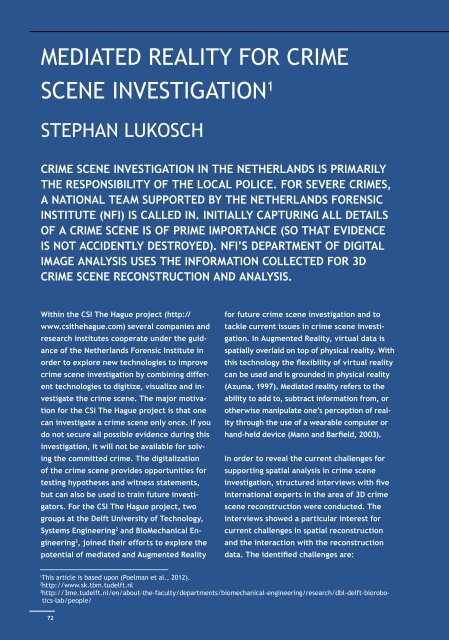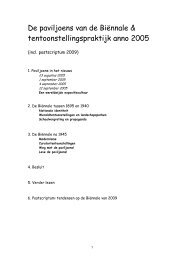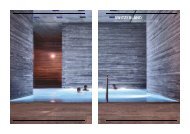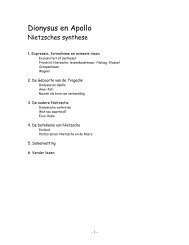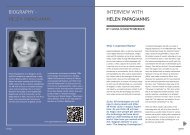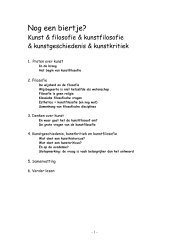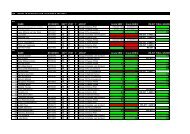download LR pdf - Kabk
download LR pdf - Kabk
download LR pdf - Kabk
You also want an ePaper? Increase the reach of your titles
YUMPU automatically turns print PDFs into web optimized ePapers that Google loves.
MEDIATED REALITY FOR CRIMESCENE INVESTIGATION 1Stephan LukoschCrime scene investigation in the Netherlands is primarilythe responsibility of the local police. For severe crimes,a national team supported by the Netherlands ForensicInstitute (NFI) is called in. Initially capturing all detailsof a crime scene is of prime importance (so that evidenceis not accidently destroyed). NFI’s Department of DigitalImage Analysis uses the information collected for 3Dcrime scene reconstruction and analysis.Within the CSI The Hague project (http://www.csithehague.com) several companies andresearch institutes cooperate under the guidanceof the Netherlands Forensic Institute inorder to explore new technologies to improvecrime scene investigation by combining differenttechnologies to digitize, visualize and investigatethe crime scene. The major motivationfor the CSI The Hague project is that onecan investigate a crime scene only once. if youdo not secure all possible evidence during thisinvestigation, it will not be available for solvingthe committed crime. The digitalizationof the crime scene provides opportunities fortesting hypotheses and witness statements,but can also be used to train future investigators.For the CSI The Hague project, twogroups at the Delft University of Technology,Systems Engineering 2 and BioMechanical Engineering3 , joined their efforts to explore thepotential of mediated and Augmented Realityfor future crime scene investigation and totackle current issues in crime scene investigation.In Augmented Reality, virtual data isspatially overlaid on top of physical reality. Withthis technology the flexibility of virtual realitycan be used and is grounded in physical reality(Azuma, 1997). Mediated reality refers to theability to add to, subtract information from, orotherwise manipulate one’s perception of realitythrough the use of a wearable computer orhand-held device (Mann and Barfield, 2003).In order to reveal the current challenges forsupporting spatial analysis in crime sceneinvestigation, structured interviews with fiveinternational experts in the area of 3D crimescene reconstruction were conducted. Theinterviews showed a particular interest forcurrent challenges in spatial reconstructionand the interaction with the reconstructiondata. The identified challenges are:1This article is based upon (Poelman et al., 2012).2http://www.sk.tbm.tudelft.nl3http://3me.tudelft.nl/en/about-the-faculty/departments/biomechanical-engineering/research/dbl-delft-biorobotics-lab/people/72Figure 1. Mediated reality head mounted device in use during the experiment in the Dutch forensic field lab.■ Time needed for reconstruction: data capture,alignment, data clean-up, geometricphysically interact with the crime scene whention: The hands of the CSIs have to be free tomodelling and analyses are manual steps.needed, e.g. to secure evidence, open doors,■ Expertise required to deploy dedicated softwareand secure evidence at the crime scene. gloves or physically touching an interfaceclimb, etc. Additional hardware such as data■ Complexity: Situations differ significantly.such as a mobile device is not acceptable.■ Time freeze: Data capture is often conducted ■ Remote connection to and collaboration withonce after a scene has been contaminated. experts: Expert crime scene investigators area scarce resource and are not often availableThe interview sessions ended with an openat location on request. Setting up a remotediscussion on how mediated reality can support connection to guide a novice investigatorcrime scene investigation in the future. Based through the crime scene and to collaborativelyanalyze the crime scene has the potentialon these open discussions, the following requirementsfor a mediated reality system that is toto improve the investigation quality.support crime scene investigation were identified:mediated reality system for collaborative spatialTo address the above requirements, a novel■ Lightweight head-mounted display (HMD): analysis on location has been designed, developedand evaluated together with experts in theIt became clear that the investigators whomarrive first on the crime scene currently carry field and the NFI. This system supports collaborationbetween crime scene investigators (CSIs)a digital camera. Weight and ease of use areimportant design criteria. Experts would like on location who wear a HMD (see Figure 1) andthose close to a pair of glasses.expert colleagues at a distance.■ Contactless augmentation alignment (nomarkers on the crime scene): The firstThe mediated reality system builds a 3D map ofinvestigator who arrives on a crime scene has the environment in real-time, allows remote usersto keep the crime scene as untouched as possible.Technology that involves preparing the Augmented space with the wearer of the HMD,to virtually join and interact together in sharedscene is therefore unacceptable.and uses bare hand gestures to operate the 3D■ Bare hands gestures for user interface opera- multi-touch user interface. The resulting medi-73


